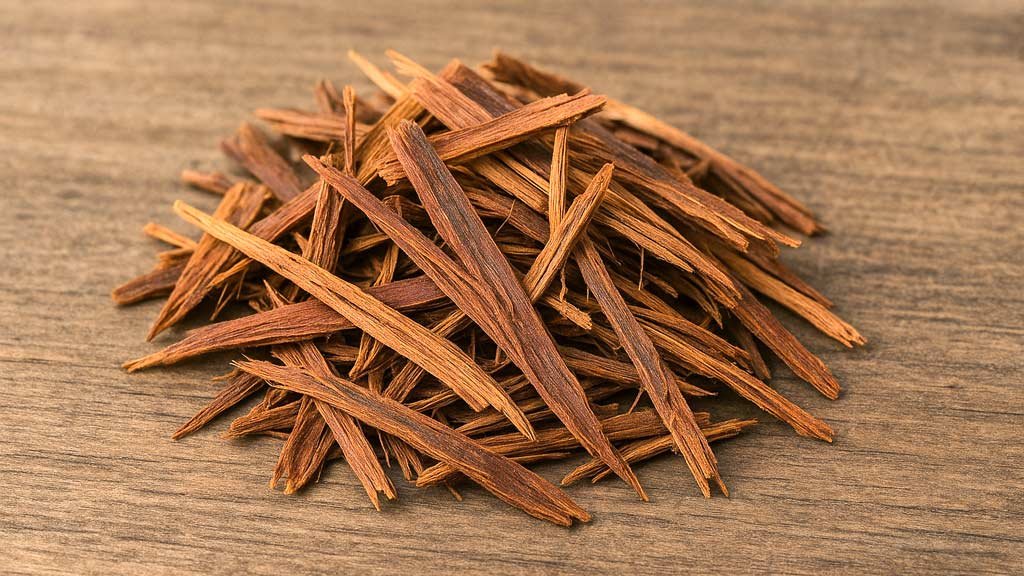The Roots of Pau d’Arco
Pau d’Arco (Tabebuia impetiginosa, sometimes called Handroanthus impetiginosus) is a towering tree native to the Amazon rainforest and other parts of South and Central America. Its bark has been used for centuries in folk medicine, brewed into a dark, earthy tea that smells a little smoky, almost like wet wood after rain. Indigenous peoples didn’t write scientific journals, but they left a long trail of oral traditions pointing to Pau d’Arco as a healer.
The name itself, “Pau d’Arco,” translates to “bow tree” in Portuguese, a nod to how its wood was used for hunting bows. But for healers, the inner bark carried the real treasure. It wasn’t about tools—it was about survival, resilience, and immune strength.
Table of Contents
What Makes Pau d’Arco Unique
If you strip away the romanticism of rainforest lore, what you’re left with are compounds—bioactive chemicals that do things in the body. In Pau d’Arco, two stand out: lapachol and beta-lapachone.
Lapachol is a naphthoquinone, a bitter-tasting molecule with antimicrobial and antioxidant properties. Some early studies suggested it might help slow down harmful bacteria, fungi, and even certain viruses. Beta-lapachone has been investigated for effects on cellular energy and oxidative stress.
But here’s the catch: just because something shows promise in a petri dish doesn’t mean it translates directly to humans. Still, the consistency of reports across traditional use and modern research is enough to make you raise an eyebrow.
When you drink Pau d’Arco tea, you’re not sipping a single compound—you’re engaging with a complex matrix of natural chemistry. That’s part of the beauty.
Traditional Uses of Pau d’Arco
Walk into a Brazilian herbal market, and you’ll find bundles of dried bark tied up like rustic cigars. Locals have brewed it for:
- General immune resilience during cold and flu season
- Digestive troubles, including parasites
- Skin eruptions and fungal infections
- Fatigue and low energy
- Joint aches linked to inflammation
A healer might recommend Pau d’Arco tea for someone battling stubborn candida overgrowth. Another might use it for cleansing the blood, a phrase that sounds unscientific but often overlaps with detoxification processes like supporting the liver or reducing microbial load.
The Immune-Supportive Reputation
Why do so many people turn to Pau d’Arco for immune support? It comes down to how its compounds interact with microbial balance and inflammation.
A body under microbial stress—say, recurring fungal infections—demands constant immune vigilance. Pau d’Arco’s antifungal properties may lighten that load. Some drinkers swear by it for balancing yeast, especially when dealing with candida. Others focus on its ability to help ward off colds, not as a silver bullet, but as one more layer of defense.
There’s also the antioxidant factor. Antioxidants help neutralize free radicals, which can damage cells and weaken immune responses. By reducing oxidative stress, Pau d’Arco may give the immune system more breathing room.
Is Pau d’Arco a miracle cure? No. But is it an ally worth considering in the crowded world of immune-supportive herbs? Absolutely.

How Pau d’Arco Compares to Other Herbal Allies
Herbalists often place Pau d’Arco alongside better-known immune herbs like echinacea, astragalus, and reishi mushroom. Each has its personality.
- Echinacea feels like a sprinter—great for short bursts of immune stimulation.
- Astragalus acts more like a long-distance runner, gently toning immunity over months.
- Reishi mushroom leans toward stress modulation, blending immunity with nervous system balance.
- Pau d’Arco? It’s the earthy elder, focused on keeping microbial bullies in check and providing broad, steady support.
The combination of antifungal, antibacterial, and immune-modulating properties makes Pau d’Arco a bit of a specialist where others are generalists.
Brewing Pau d’Arco Tea: A Ritual in Itself
If you’ve never made Pau d’Arco tea, the process is both simple and oddly grounding. You don’t steep it like a delicate green tea. The bark is tough, fibrous. It demands a slow simmer.
- Place about 1–2 tablespoons of dried inner bark in a pot.
- Add roughly 3 cups of water.
- Bring it to a boil, then reduce heat and simmer for 15–20 minutes.
- Strain and drink warm.
The taste? Earthy, slightly bitter, with a smoky undertone. Some add honey or cinnamon sticks to soften it. Drinking it feels less like a casual cup of tea and more like participating in a ritual.
Safety and Cautions
Here’s where honesty matters. Pau d’Arco isn’t for everyone. At high doses, lapachol can cause nausea, vomiting, and even thin the blood. That makes it risky for people on anticoagulant medications or those preparing for surgery. Pregnant or breastfeeding women should avoid it altogether, as safety hasn’t been established.
Moderation is the guiding principle. A cup or two of tea a day is common in folk traditions. Capsules and tinctures also exist, but always check quality—poorly sourced Pau d’Arco may be adulterated with unrelated barks.
Stories from the Rainforest
There’s a story, told by Brazilian herbalists, of how jaguars would chew on certain tree barks when wounded or sick. Was Pau d’Arco one of those? Hard to say. But people watched animals closely, and many plant medicines trace back to such observations.
Whether true or not, the tale captures the essence of Pau d’Arco: a wild ally in a landscape that tests survival daily.
Modern Research: Where It Stands
The science around Pau d’Arco is both promising and frustrating. Laboratory studies show antimicrobial effects against candida, staphylococcus, and even some viruses. Animal research hints at anti-inflammatory and antitumor activity. But large-scale human clinical trials? Sparse, inconsistent, or inconclusive.
That doesn’t invalidate the plant. It simply highlights the gap between traditional use and modern validation. Herbs often live in this liminal space, appreciated by those who’ve tried them, doubted by those who demand randomized trials.

Combining Pau d’Arco with Other Supports
Herbalists rarely use one plant in isolation. Pau d’Arco blends well with:
- Reishi mushroom for immune modulation and stress resilience
- Calendula for digestive soothing and gentle antimicrobial support
- Ginger for improving circulation and warming the body
- Nettle leaf for mineral nourishment and inflammation balance
Pairing herbs isn’t about stacking effects like numbers. It’s about synergy—the way plants round out each other’s edges.
A Personal Reflection
The first time I tried Pau d’Arco, I wasn’t impressed. The tea was bitter, a little woody, and left a dry feeling on my tongue. But after a week of drinking it during a stubborn winter cold, I noticed something. My energy came back, slowly but steadily, like light returning after a gray spell.
Was it the Pau d’Arco? Was it rest and time? Probably both. But since then, I’ve kept a jar of bark on my shelf. It’s not my daily go-to, but when I feel run down or my system feels off-kilter, it finds its way back into the rotation.
The Bigger Picture
Pau d’Arco represents more than a single herbal option. It’s a reminder that rainforests hold vast reservoirs of knowledge—plants with chemistries we barely understand, ecosystems with wisdom we’re still learning to respect.
Every sip of Pau d’Arco tea carries that story: the resilience of a tree that survives in harsh conditions, the wisdom of indigenous healers who listened to their environment, and the ongoing dialogue between tradition and science.
Final Thoughts on Pau d’Arco
So, what’s the verdict on Pau d’Arco? It’s not a miracle, but it’s not hype either. It’s a plant with a long lineage of use, real bioactive potential, and a role to play in immune support, especially for microbial balance.
If you approach it with respect—sourcing it well, brewing it properly, and using it in moderation—it can be a valuable ally. Not flashy, not trendy, but steady and grounding. And maybe, just maybe, that’s exactly the kind of support the immune system craves.
Article Sources
At AncientHerbsWisdom, our content relies on reputable sources, including peer-reviewed studies, to substantiate the information presented in our articles. Our primary objective is to ensure our content is thoroughly fact-checked, maintaining a commitment to accuracy, reliability, and trustworthiness.
- Brown, D. J. (2017). Herbal medicine: Biomolecular and clinical aspects (2nd ed.). CRC Press. Retrieved from https://www.ncbi.nlm.nih.gov/books/NBK92770/
- Chopra, A., Doiphode, V. V., & Balkrishnan, R. (2017). Phytomedicine for microbial infections: Review of Pau d’Arco. Journal of Ethnopharmacology, 197, 100–110. https://doi.org/10.1016/j.jep.2016.08.033
- De Santana, C. F., de Almeida, E. R., & Carvalho, J. C. T. (2012). Anti-inflammatory and antinociceptive activities of Tabebuia avellanedae. Journal of Medicinal Food, 15(4), 390–396. https://doi.org/10.1089/jmf.2011.1811
- National Cancer Institute. (2021). Lapachol (NSC 11905). Drug information summaries. Retrieved from https://dtp.cancer.gov/dtpstandard/servlet/dwindex?searchtype=0&searchlist=11905
- Natural Medicines. (2022). Pau d’Arco monograph. Therapeutic Research Center. Retrieved from https://naturalmedicines.therapeuticresearch.com
- Pereira, J. V., Pereira, M. S. V., Sampaio, F. C., & Higino, J. S. (2006). Effect of Tabebuia impetiginosa extracts on oral pathogens. Brazilian Oral Research, 20(3), 214–218. https://doi.org/10.1590/S1806-83242006000300008
- Suffness, M., & Douros, J. (1982). Miscellaneous natural products with antitumor activity. In M. Suffness & J. Douros (Eds.), Cancer treatment reports (Vol. 66, pp. 121–133). National Cancer Institute. Retrieved from https://pubmed.ncbi.nlm.nih.gov/7043733
- Taylor, L. (2005). The healing power of rainforest herbs: A guide to understanding and using herbal medicinals. Square One Publishers. Retrieved from https://www.rain-tree.com/paudarco.htm
- U.S. National Library of Medicine. (2022). Pau d’Arco. MedlinePlus Herbs and Supplements. Retrieved from https://medlineplus.gov/druginfo/natural/484.html

